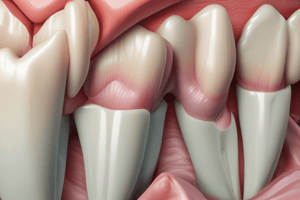Podcast
Questions and Answers
What primarily governs the degree of dentin permeability to restorative materials?
What primarily governs the degree of dentin permeability to restorative materials?
- The thickness of dentin between the cavity floor and pulp (correct)
- The overall health of the dental pulp
- The age of the patient
- The composition of the restorative materials
Which of the following components has shown to penetrate dentin and potentially affect the pulp?
Which of the following components has shown to penetrate dentin and potentially affect the pulp?
- Sodium fluoride
- Triethylene glycol dimethacrylate (resin monomer) (correct)
- Calcium hydroxide
- Glass ionomer cement
What is the general nature of the effect of certain chemicals on the dental pulp in the absence of bacteria?
What is the general nature of the effect of certain chemicals on the dental pulp in the absence of bacteria?
- They cause irreversible damage
- They have a temporary and reversible effect (correct)
- They stimulate excessive mineralization
- They induce a long-lasting inflammatory response
What role do acid etchants play in relation to restorative materials and the dental pulp?
What role do acid etchants play in relation to restorative materials and the dental pulp?
Which factor does NOT influence the permeability of dentin to restorative materials?
Which factor does NOT influence the permeability of dentin to restorative materials?
What is the effect of calcium hydroxide when used on exposed pulps?
What is the effect of calcium hydroxide when used on exposed pulps?
How does the irritation potential of calcium hydroxide contribute to its effectiveness in restorative dentistry?
How does the irritation potential of calcium hydroxide contribute to its effectiveness in restorative dentistry?
What impact does glass ionomer have on pulp tissues?
What impact does glass ionomer have on pulp tissues?
Which statement about the hybrid layer created between resin and dentin is correct?
Which statement about the hybrid layer created between resin and dentin is correct?
What role do bioactive molecules play when liberated by calcium hydroxide and mineral trioxide aggregates (MTAs)?
What role do bioactive molecules play when liberated by calcium hydroxide and mineral trioxide aggregates (MTAs)?
Study Notes
Dentin Permeability and Restorative Materials
- The permeability of dentin is a key factor in pulp reactions to restorative materials.
- Dentin thickness between the cavity preparation and the pulp is the most important variable in dentin permeability.
- Dentin permeability can be influenced by age and caries status.
Direct Effects of Restorative Materials on Pulp
- Unbound components of resin materials and preparative agents can induce an inflammatory response in the pulp.
- Resin monomers (e.g., triethylene glycol dimethacrylate and 2-hydroxyethyl methacrylate) penetrate dentin and can affect the pulp.
- Eugenol and components of Ledermix (triamcinolone and demeclocycline) can also pass through dentin and affect the pulp.
- Cytotoxic components of resin restorations can lead to chronic stimulation and a prolonged inflammatory response.
- Subtoxic concentrations of certain agents can trigger allergic reactions in humans.
- Foreign body reactions can occur with extruded globules of resin material, leading to macrophage and giant cell formation.
- Resin monomers can decrease the activity of immunocompetent cells in a dose-dependent manner.
Indirect Effects of Restorative Materials on Pulp
- Desiccation and demineralization of dentin can contribute to pulp irritation.
- Technique sensitivity of certain materials can lead to faulty bonds and subsequent dentin hypersensitivity, recurrent disease, and pulp inflammation.
- Dry preparation surfaces can result in defective bonds, particularly with resin-bonded materials.
Pulp Reactions to Specific Restorative Materials
- Calcium hydroxide is used to stimulate dentinal bridge formation in pulp exposures.
- It induces a low-grade pulp irritation, which is necessary for dentin bridge formation.
- Aqueous suspensions of calcium hydroxide cause superficial necrosis of pulp tissue followed by low-grade inflammatory changes.
- Hard-setting calcium hydroxide preparations and mineral trioxide aggregates (MTAs) elicit dentin bridge formation with minimal to no necrotic zone.
- Calcium hydroxide application to intact dentin promotes sclerosis by promoting crystal precipitation within dentinal tubules, reducing permeability.
- Calcium hydroxide and MTA liberate bioactive molecules from dentin, such as TGF-β1 and adrenomedullin, facilitating hard tissue formation.
- Acid etching and chelating agents (e.g., EDTA) can also liberate bioactive molecules from dentin, including growth factors and metalloproteinases.
- Glass ionomers can damage pulp tissues due to their lowered pH and release of high concentrations of fluoride.
- Glass ionomers are toxic to pulp cells in direct contact, but can induce reparative dentin formation when applied to intact dentin.
Restorative Materials with Medicinal Properties
- Zinc oxide and eugenol (ZOE) have anesthetic and antiseptic properties.
- ZOE can block action potentials in nerve fibers, suppress nerve excitability in the pulp, and inhibit bacterial growth.
- ZOE is often used for temporary fillings due to its short-term effectiveness.
Studying That Suits You
Use AI to generate personalized quizzes and flashcards to suit your learning preferences.




